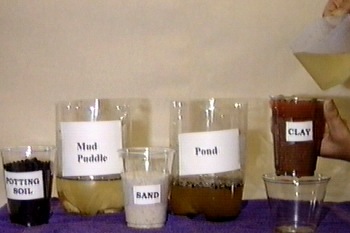![]()
Activity:
Dirt Cleans Up
![]()
|
Purposes:
|
1. To demonstrate filtering properties of three soil types. 2. To demonstrate percolation efficiency of three soil types. 3. To explain how soil type affects runoff of liquids. |
|
Materials:
|
samples of water, 10oz. clear plastic drink cups, small clear container no less than one cup in size, samples of sand, *clay, and potting soil, small tack to punch holes *(If you live in the Coastal Plains of South Carolina, clay will be found as the second layer of soil in most yards after the sandy soil.) |
|
Procedures:
|
1. Collect water samples from several sources (ie. lakes, ponds, ditches, mud puddles, wells, etc.) Label each as to site. |
|
|
2. Punch 4 holes in the bottom of each 10oz. cup. Label each as either sand, clay, or potting soil. 3. Loosely place an equal amount of each soil sample in its respective container. |
|
|
|
|
||||||||||
|
To Ponder...
|
1. Which soil is the best filter? Why? 2. Why is it important to know what is being poured onto the ground near your well? 3. Why do farmers need to know soil types if they need to add nutrients to their fields? 4. Where would fertilizer go if it does not remain in the field where it is applied? |

